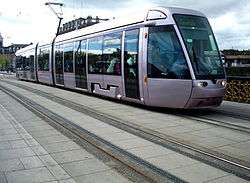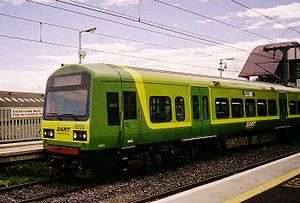Public transport in Ireland

Public transport in Ireland exists in many of the island's urban areas, and takes a number of forms. Bus transport is the main form of public transport common in all cities. The cities, Dublin, Cork, Limerick and Galway all have their own suburban rail networks. Ireland has a population of over 6.4 million people.
Transport for Ireland is a public information body set up by the National Transport Authority as a single point of reference for all public transport in Ireland, along the lines of Transport for London.
Provision by area
Dublin

The Greater Dublin area has a population of 1.7m and there are a number of modes of public transport in the GDA run by a number of transport operators, most of them state or quasi-state entities. Public transport in Dublin is overseen by the National Transport Authority. It has undergone expansion in recent years, and the Irish Government plans to invest heavily[1] in the system under the Transport 21 plan which means that approximately 20 billion euro will be spent on developing Greater Dublin's transport infrastructure. Dublin's transit system utilises electrified suburban trains, diesel commuter rail, trams and an extensive bus network to provide service to the population of the Greater Dublin Area.
Buses are the most widely used form of public transport in Dublin. They are operated by Dublin Bus. The bus network consists of 200 bus routes covering the Dublin Region. The Bus Arrival Information Service is being rolled out across Dublin, and provides real time estimates of bus arrivals at each stop, based on GPS locations of buses.
Dublin also has a commuter rail system, one of five suburban rail networks on the island. The system uses diesel-powered trains and an electrified line. There are four main lines, designated Northern Commuter, Western Commuter, South Eastern Commuter, and South Western Commuter. The trains are operated by Iarnród Éireann.
The Dublin suburban network also consists of an electrified line Dublin Area Rapid Transit that serves the Dublin bay commuter belt.
- Northern Commuter – Dublin Pearse to Dundalk.
- South Eastern Commuter – Dublin Connolly to Wicklow.
- South Western Commuter – Dublin Heuston to Kildare.
- Western Commuter – Dublin Pearse / Docklands to Longford.
- Dublin Area Rapid Transit (DART) – Greystones to Howth/Malahide.
There is also a tram network called LUAS consisting of two lines;
- Red Line: Tallaght to Connolly
- Green Line: St. Stephen's Green to Sandyford
As of 2006, the Dublin Metro is a planned two-line rapid transit (underground) system set out in the Irish government's 2005 Transport 21 plan to spend 20 billion euro on infrastructure in the Greater Dublin area up until 2021. The estimated cost of the 17km Metro North is approximately 5 billion euro and will be the biggest and most expensive infrastructural project ever undertaken on the island of Ireland.
Cork
The Greater Cork area has a population of 400,000 and is covered mainly by bus and suburban rail networks as well as a commuter ferry.
There are a total of 35 bus routes of which, 18 are Citybus routes serving areas like Cork City, Knocknaheeny, Ballinlough, Cork, Mahon, Cork, Mayfield, Cork, Frankfield, Cork, Ballintemple and Farranree, Cork and 17 suburban routes serving towns such as Glanmire, Ballincollig, Carrigaline, Douglas, Midleton, Mallow, Cobh and Goleen.
By 2010, there will be 3 suburban train lines in the Cork Suburban Rail service.
- Cork Kent – Blarney ED (15,000) – Mallow (11,000)
- Cork Kent – Glanmire (16,000) – Cobh (12,000)
- Cork Kent – Glanmire (16,000) – Midleton (11,000)
There is also a car ferry operating between Rushbrooke and Passage West.
Limerick
The Limerick urban area has a population of 140,000 and is covered mainly by bus and suburban rail networks.
There are a total of 9 Citybus routes, serving areas such as Raheen, Dooradoyle, Ballycummin, University of Limerick, O'Malley Park, Caherdavin and Castletroy.
Commuter rail services are also important and there are three train lines in the Limerick Suburban Rail network.
- Limerick railway station – Ennis (25,000)
- Limerick railway station – Nenagh (9,000)
- Limerick railway station – Tipperary (5,000)
Derry
The Derry City area has a population of 110,000, with a greater hinterland of 350,000 is served by both rail and bus services provided by the public transport company Translink. There are 15 bus routes serving parts of the city. The routes cover all parts of the city except for the Culmore area. This was served until April 2014 by Lough Swilly bus fleet, which had the monopoly on the route due to licensing rights with the DVLNI. This service is now run by Ulsterbus Foyle. For the various surrounding towns and villages around the city, there are Ulsterbus services travelling into the city centre.
The city is serviced by Waterside Station on the Belfast-Derry line which serves Belfast Central and Belfast Great Victoria Street, running via Coleraine (for the Coleraine-Portrush railway line to Portrush) and Antrim. The railway line was upgraded with a track relay and planned passing loops to be installed [2]
Galway
The city of Galway has a population of 70,000 and there are two companies providing bus services throughout the city – Bus Éireann and Galway City Direct. There are 16 bus routes serving the city and its suburbs altogether – Bus Éireann operates 11 routes, while Galway City Direct runs 5 routes.
GalwayTransport.info was set up in 2009 to provide information about public transport services currently operating in Galway city and the surrounding area. It includes a summary map of all city bus service routes, a detailed map and timetable link for each route, as well as specific instructions about getting to popular places (work and recreation) using public transport.
From 2008 on, Galway Suburban Rail will have one rail line connecting Galway and the satellite towns of Oranmore (5,000) and Athenry (3,000).
Overview table
The table below lists cities in Ireland that have public transport systems. It includes only internal services (as opposed to services between towns).
| City | Buses | Urban rail | Metro | Light rail | Ferry |
|---|---|---|---|---|---|
| Dublin | {Planned} | ||||
| Cork | |||||
| Limerick | |||||
| Derry | |||||
| Galway | |||||
| Waterford |